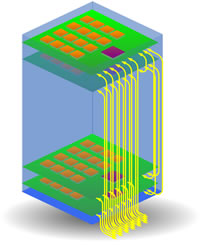About
23 February 2012
Transforming Computers of the Future with Optical Interconnects
FOR IMMEDIATE RELEASE
Contact:
Lyndsay Meyer
The Optical Society
+1.202.416.1435
lmeyer@osa.org
Transforming Computers of the Future with Optical Interconnects
OFC/NFOEC 2012 to feature talk on future computing architectures enabled by optical and nanophotonic interconnects

HyperX optical interconnect fabric. This sketch shows an optically connected topology called “HyperX.” Image courtesy of HP Labs.
WASHINGTON, Feb. 23— In order to build the next generation of very large supercomputers, it’s essential that scientists and engineers find a way to seamlessly scale computation performance without exceeding extraordinary power consumption. It is widely agreed that the major challenge to scaling future systems will no longer be the CMOS (Complementary Metal–Oxide–Semiconductor) integrated circuit technology but rather the data movement among processors and memory. The rapidly evolving technology of photonic interconnects promises to deliver this increase in computing capabilities by providing ultra-high communication bandwidths with extreme energy efficiency and should therefore provide the impetus to move the technology from the lab into actual products.
The ability to manufacture photonic interconnect components—modulators, detectors, waveguides, and filters—on silicon substrates has finally been realized, and these optical interconnect structures show great potential for both intrachip and interchip applications.
HP Labs, the central research lab for Hewlett Packard (HP) in Palo Alto, Calif., is studying how this shift to light-based interconnects may revolutionize the way computers are built. Moray McLaren of HP will present his findings at the Optical Fiber Communication Conference and Exposition/National Fiber Optic Engineers Conference (OFC/NFOEC), taking place March 4–8 at the Los Angeles Convention Center.
“This is an exciting time because it’s a big transition for the industry,” says McLaren, a researcher in HP Labs’ Exascale Computing Lab, focused on inventing computer fabrics for next-generation IT solutions using a cross-layer, interdisciplinary approach. “In many respects, it’s one of the inevitable forces of technology that’s been much-heralded for 10 years. There’s finally industry-wide agreement that it will happen. We’ve reached the point where we can say that it’s an essential technology—we’ll need to have optical interconnects to deliver these machines in the 2017-2019 timeframe.”
How will these optical technologies change the way computers are built? Computer architects hold essentially two views on the role photonics will play.
One widely held view is that photonic interconnects are simply “smarter wire,” explains McLaren. “Today’s computers are connected with copper cable up to a certain distance, currently about 8 meters, and as data rates continue to increase, this threshold will drop to less than a meter. And once the threshold is exceeded, the interconnect transitions from copper to optics.”
While high-speed electronic interconnects are becoming increasingly range-limited, they still tend to cost less than optical interconnects. “The result is that people are contorting the way they build systems to use as many of the less expensive electronic connections as possible—and non-optimal wiring topologies,” notes McLaren.
The other viewpoint suggests that the characteristics and capabilities of optical communication are sufficiently different to the way things are done electronically—meaning that we need to entirely rethink how to build computers.
“There are things that we might do differently because the characteristics of optical interconnects are different,” McLaren points out. “One very simple example is that within a data center, distance isn’t much of a factor after you’ve transitioned to an optical interconnect. Having paid the price of moving from the electronic domain into the optical domain, we can connect up any distance.”
Another related topic that HP Labs is investigating, in terms of data centers, is pushing down power consumption. The power for computational parts is still reducing with Moore’s Law, along with the shrinking size of the individual transistors. But the power related to electronic communication isn’t shrinking nearly as much because it’s tied to real-world connectors and cables that don’t scale in the same way.
Two of the key benefits of photonics are that it has the potential to provide lower-power communication over certain distances, and moving into the optical world provides more headroom in channel capacity and bandwidth densities are much higher. “Photonic interconnects have very different properties than the electronic interconnects that underpin today’s computer architectures. To gain the maximum benefit from emerging nanophotonic interconnects, it’s necessary to reevaluate the design tradeoff at the system architect level,” McLaren notes.
Techniques that have fallen out of use in the electronic domain due to signal integrity considerations, such as broadcast and circuit switching, can be exploited to significant advantage in optical interconnects. Moving forward, the development of integrated CMOS nanophotonics will be critical to achieving the objectives of the most demanding computer development programs.
McLaren’s presentation at OFC/NFOEC, titled “Future computing architectures enabled by optical and nanophotonic interconnects,” will take place Tuesday, March 6 at 5 p.m. in the Los Angeles Convention Center.
EDITOR’S NOTE: A high-resolution graphic representation of HP’s optically connected topology called HyperX is available to members of the media. Contact Lyndsay Meyer, lmeyer@osa.org.
About OFC/NFOEC
For more than 35 years, the Optical Fiber Communication Conference and Exposition/National Fiber Optic Engineers Conference (OFC/NFOEC) has been the premier destination for converging breakthrough research and innovation in telecommunications, optical networking and, recently, datacom and computing. Uniting service providers, systems companies, enterprise customers, IT businesses and component manufacturers, along with researchers, engineers and development teams, OFC/NFOEC combines dynamic business programming, an exposition of more than 500 companies and cutting-edge peer-reviewed research into one event that showcases the trends and pulse of the entire optical communications industry.
OFC/NFOEC is managed by the Optical Society (OSA) and co-sponsored by OSA, the Institute of Electrical and Electronics Engineers/Communications Society (IEEE/ComSoc) and the IEEE Photonics Society. Acting as a non-financial technical co-sponsor is Telcordia Technologies, Inc. Visit www.ofcnfoec.org.
###
